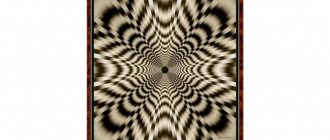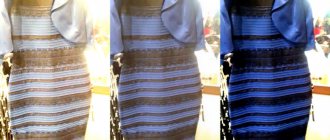Perception is a process that forms the image of objects and phenomena from the surrounding world into the structures of the psyche. This is a complete reflection of the qualities and inherent characteristics of an object and phenomenon. This is a kind of collapsed thinking. It is often interpreted not as a process, but as a result, that is, the image of the object itself. Perception is synonymous with perception, therefore the image of an object is formed with the help of the perception of primary sensations, certain knowledge, desires, expectations, imagination and mood. The main features of perception are objectivity, constancy, integrity, apperception, structure, meaningfulness, illusion, selectivity.
Perception has many synonyms: apperception, perception, evaluation, understanding, acceptance, contemplation.
Perception in psychology
Perception in psychology is the process of displaying the characteristic properties of objects and phenomena in the psyche, when the sense organs are directly influenced. There was a long hour of discussion regarding sensations and their importance in perception. Associative psychology interpreted sensations as basic elements of the psyche. Philosophy criticized the idea that perception is built from sensations. In the 20th century, some changes occurred in psychology; perception is no longer considered as a set of atomic sensory sensations, but began to be understood as a structural and holistic phenomenon. Psychologist J. Gibson interprets perception as an active process of appropriating information from the world, which includes a real examination of the information that is perceived. Thus, this process shows a person the properties of the surrounding world related to his needs, and demonstrates his possible activities in the actual real situation.
Another psychologist W. Nesser insisted that perception in psychology is the process of extracting information from objects of the external world, which is carried out on the basis of schemes of various objects and the whole world that exist in the subject. These patterns are learned through experience, and there are also underlying themes that are innate. A similar idea was held by supporters of cognitive psychology, who believe that perception is the process of categorizing perceived information, that is, assigning perceived objects to a certain category of objects. Some categories are innate - this is information about the surrounding nature and the closest objects that a child is able to correlate with some category, and there are categories that include objects, knowledge about which is gained through experience.
In the human mind, the reflection occurs through a direct influence on the analyzers.
Methods of perception depend on the system that will be influenced. Through perception, people can become aware of what is happening to them and how the world affects them.
This process was previously described as the summation of certain sensations, or a consequence of elementary associations of individual properties. Still, there remains a part of psychologists who consider perception as a set of sensations that appear as a result of direct sensory cognition, which are interpreted as subjective experiences of the quality, localization, strength and other properties of the influence of stimuli.
This definition is incorrect, so contemporaries describe this process as a reflection of whole objects or phenomena. Selects from a complex of influencing stimuli (shape, color, weight, taste, etc.) the most basic ones, while simultaneously distracting from unimportant stimuli. It also combines groups of significant features and compares the perceived complex of signs with previously known knowledge about the subject.
When perceiving familiar objects, their recognition occurs very quickly; a person simply combines two or three properties into a whole and comes to the desired decision. When unfamiliar, new objects are perceived, their recognition is much more complex and occurs in broader forms. As a result of the analytical-synthetic process, essential features are identified that do not allow others to reveal themselves, insignificant and combining perceived elements are linked into a single whole, and a complete perception of the object arises.
The process of perception is complex, active, and requires significant analytical and synthetic work. This nature of perception is expressed in many signs that require special consideration.
The process of perception has motor components with the help of which the perception of information is realized (eye movement, feeling objects). Therefore, this process would be more accurately defined as the perceptual activity of the individual.
The process of perception is never limited to one modality, but has a well-coordinated relationship between several analyzers, as a result of which ideas that have formed in the individual appear. It is very important that the perception of objects never occurs at an elementary level, but operates at the highest levels of the psyche.
When a person has a watch in front of his eyes, he mentally names this object, not paying attention to unimportant properties (color, shape, size), but highlights the main property - indicating the time. He also classifies this object into the appropriate category, isolates it from other objects that are similar in appearance, but those that belong to a completely different category, for example, in this case, a barometer. This confirms that the process of perceiving a person is close in psychological structure to visual thinking. The active and complex nature of perception determines its characteristics, which apply equally to all forms.
Peculiarities of perception constitute the main characteristic of perceived objects. They are also properties of these objects, phenomena and objects.
Peculiarities of perception: objectivity, integrity, structure, constancy, comprehension, apperception.
The objectivity of perception is observed in the attribution of knowledge acquired from the outside world to this world. Performs regulatory and orienting functions in practical activities. It is created on the basis of external motor processes that ensure contact with the object. Without movement, perception would not have a relationship with the objects of the world, that is, the property of objectivity. It also plays a role in regulating the subject’s behavior. Usually objects are defined not by their appearance, but according to their practical purpose or basic property.
Constancy is defined in the relative constancy of properties in objects, even if their conditions change. With the help of the compensating property of constancy, the subject is able to perceive objects as relatively stable. For example, constancy in the perception of colors is the relative immutability of visible color under the influence of lighting. Color constancy is also determined by certain reasons, among them: adaptation to the level of brightness in the visual field, contrast, ideas about natural color and its lighting conditions.
The constancy of size perception is expressed in the relative constancy of the visible dimensions of an object at different distances. If an object is relatively close to the distance, its perception is determined by the action of additional factors, of particular importance among them is the effort of the eye muscles, which adapt to fixing the object while moving it away at different distances.
The perception of the shape of objects, their constancy is expressed in the relative stability of its perception when their positions change relative to the line of sight of the observing subject. During any change in the position of an object in relation to the eyes, its image shape on the retina changes, with the help of eye movements along the contours of objects and the selection of characteristic combinations of contour lines known to the subject from past experience.
A study of the evolution of the origin of the constancy of perception of people leading their lifestyle in a dense forest, not seeing objects at various distances, only around them. They perceive objects located at a far distance as small, not distant. For example, builders can see objects below without distorting their size.
The source of the property of constancy of perception is the actions of the perceptual system of the brain. When a person repeatedly perceives the same objects in different conditions, the stability of the perceptual image of the object is ensured, relative to changeable conditions and movements of the perceiving receptor apparatus itself. Consequently, the approach to constancy stems from a kind of self-regulating action, which has a feedback mechanism and adapts to the characteristics of the object, the conditions and circumstances of its existence. If a person lacked constancy of perception, he would not be able to navigate the constant variability and diversity of the surrounding world.
The integrity of perception provides greater information content, in contrast to sensations that reflect individual characteristics of an object. Integrity is formed on the basis of general knowledge about its individual properties and characteristics of an object, taken in the form of sensations. The elements of sensation are very strongly connected with each other and the only complex image of an object arises when a person is under the direct influence of some properties or parts of the object. Impressions from this arise as a conditioned reflex as a result of the connection between visual and tactile influence, which was formed in life experience.
Perception is not a simple summation of human sensations, and does not respond to them instantly. The subject perceives a generalized structure actually isolated from sensations, which is formed during a certain time. When a person listens to music, the rhythms he heard will continue to sound in his head when a new rhythm arrives. He who listens to music perceives its structure holistically. The last note heard cannot form the basis of such an understanding; the whole structure of the melody continues to be played in the head with various interrelations of the elements it includes. Integrity and structure lie in the properties of reflected objects.
Human perception has a very close connection with thinking. Therefore, the peculiarity of meaningful perception will play a very important role. Although the process of perception arises under the influence of direct influence on the senses, perceptual images always have semantic meaning.
Conscious perception of objects helps a person mentally name the object and assign it to a designated category or group. When a person encounters a new object for the first time, he tries to establish some similarity with already familiar objects. Perception is a constant search for the best description of the available data. How an object is perceived by a person depends on the stimulus, its characteristics, and the person himself. Since a living whole person perceives, and not individual organs (eyes, ears), therefore the process of perception is always influenced by the specific characteristics of the individual.
The dependence of perception on the influence of mental characteristics of a person’s life, on the properties of the subject’s personality itself, is called apperception. If subjects are presented with unfamiliar objects, then in the first phases of their perception, they will look for standards in relation to which the object that is being presented can be attributed. During perception, hypotheses regarding the belonging of an object to a certain category are put forward and subject to testing. Thus, during perception, traces from past experience and knowledge are used. Therefore, one object can be perceived differently by different people.
The content of perception is determined by the task assigned to the subject, his motivation; in his process, attitudes and emotions have meaning that can change the content of perception. These conditions are necessary for the subject’s orientation in the surrounding world.
A thousand answers to the most important questions
Psychological presents to your attention a conceptually new approach in the field of practical psychology. Which combines the most advanced and valid methods of providing emergency psychological assistance, as well as options for short-term and prolonged psychological and therapeutic work, which is aimed at achieving qualitative changes in a person’s psycho-emotional state. This beneficial effect is due to the modern, innovative method of psychotherapist M. V. Nurullin - mesopsychology (compositional psychology).
This method combines all the diversity of revolutionary ideas in the world of psychology and is an integrative approach that combines both well-known classical areas of psychotherapy and experimental methods.
Mesopsychology involves a five-step approach to different levels of modality of human perception. The scheme is simple, but this ensures its accessibility to the average person and has an excellent therapeutic effect. But first things first…
Types of perception
There are several classifications of types of perception. First, the perception is divided into intentional (voluntary) or intentional (voluntary).
Intentional perception has an orientation with the help of which it regulates the process of perception - this is to perceive an object or phenomenon and become familiar with it.
Arbitrary perception can be included in some activity and realized in the process of its activity.
Unintentional perception does not have such a clear direction, and the subject does not set out to perceive a specific object. The direction of perception is influenced by external circumstances.
As an independent phenomenon, perception manifests itself in observation. Observation is a deliberate, systematic and long-term perception over a certain period of time, aimed at tracking the course of some phenomenon or changes occurring in the object of perception.
Observation is an active form of human sensory cognition of reality. During observation, as an independent purposeful activity, from the very beginning there is a verbal formulation of tasks and goals that orient the observation process towards certain objects. If you practice observation for a long time, you can develop such a property as observation - the ability to notice characteristic, subtle features and details of objects that do not immediately catch the eye.
To develop observation skills, an organization of perception is necessary that meets the necessary conditions of success, clarity of the task, activity, preliminary preparation, systematicity, and planning. Observation is necessary in all spheres of human life. Already from childhood, in the process of playing or learning, it is necessary to place emphasis on the development of observation, versatility and accuracy of perception.
There is a classification of perceptions according to: modality (visual, olfactory, auditory, tactile, gustatory) and forms of perception of the existence of matter (spatial, temporal, motor).
Visual perception is the process of creating a visual image of the world based on sensory information perceived through the visual system.
Auditory perception is a process that ensures the receptivity of sounds and orientation according to them in the environment, carried out using an auditory analyzer.
Tactile perception is based on multimodal information, the leading one being tactile.
Olfactory perception is the ability to sense and distinguish odorous substances as odors.
Taste perception - the perception of stimuli acting on the receptors of the mouth, characterized by taste sensations (sweet, salty, bitter, sour).
More complex forms of perception are the perception of space, movement and time.
Space is formed by the perception of shape, size, location and distance.
Visual perception of space is based on the perception of the size and shape of an object, thanks to the synthesis of visual, muscle, tactile sensations, perception of volume, distance of objects, which is carried out by binocular vision.
A person perceives movement because it occurs against a specific background, which allows the retina to display in a certain sequence the resulting changes in positions that are in motion relative to the elements in front of and behind which the object is moving. There is an autokinetic effect when in the dark a luminous stationary point appears to be moving.
The perception of time has been studied a little less, since there are many complexities in this process. The difficulty in explaining how a person perceives time is that there is no obvious physical stimulus in the perception. The duration of objective processes, that is, physical time, can be measured, but duration itself is not a stimulus in the literal sense of the word. There is no energy in time that would act on a certain temporary receptor, for example, as is observed in the influence of light or sound waves. To date, no mechanism has been discovered that indirectly or directly converts physical time intervals into corresponding sensory signals.
Perception of information is an active, semi-conscious process of the subject’s activity in receiving and processing significant knowledge about the surrounding world, events and people.
The perception of information is carried out under the influence of certain circumstances. Firstly, the situation in which the information was acquired matters. A favorable situation will promote a more favorable perception than the information is worth, and conversely, an unfavorable situation will promote a negative perception of the information than it actually is.
Secondly, the depth of understanding of the situation. A person who is well versed in the situation in most cases is calmer about information, related events and the people around him at that moment. He does not dramatize what is happening, does not exalt, and assesses the situation very adequately than a person with a limited outlook.
Thirdly, the perception of information is influenced by the characteristics of the phenomenon, subject or object that the information indicates.
Fourthly, stereotypes (simplified standardized representations of complex phenomena and objects of the surrounding reality) have a great influence. Stereotypes are an idea based on the views of others about those things that a person has not yet encountered, but may encounter and, thus, facilitate his understanding of these things.
Fifthly, perception often becomes more difficult, under the influence of unpredictability or distortion of information, the inability to correctly present information.
Person's perception by person
When people meet for the first time, they, perceiving each other, highlight features of appearance that represent their mental and social qualities. Particular attention is paid to posture, gait, gestures, cultural speech, behavioral patterns, habits, and manners. One of the first and most important is professional characteristics, social status, communication and moral qualities, how angry or warm-hearted a person is, sociable or uncommunicative, and others. Individual facial features are also selectively highlighted.
The characteristics of a person are interpreted by their appearance accordingly in several ways. The emotional way is expressed in the fact that social qualities are attributed to a person, depending on his appearance and aesthetic appeal. If a person is outwardly beautiful, then he is good. Very often people fall for this trick; it is worth remembering that appearances can be deceiving.
The analytical method assumes that each element of appearance is associated with a specific mental property characteristic of this person. For example, frowning eyebrows, compressed lips, and a frowning nose indicate an angry person.
The perceptual-associative method consists of attributing to a person qualities in which he seems similar to another person.
The social-associative method assumes that a person is assigned qualities of a certain social type in relation to his individual external signs. Such a generalized image of a person influences communication with this person. People often identify a person without a fixed place of residence by torn clothes, dirty pants, torn worn-out shoes and try to keep their distance from him.
The perception of a person by a person lends itself to social stereotypes, measures, and standards. The idea of the social status of an individual, the general idea of him, is transferred to other manifestations of this personality, this is the halo effect. The primacy effect suggests that the initial perceived information heard from other people about a person can influence the perception of him when meeting him, will be of predominant importance.
The effect of social distance is generated by significant differences in the social status of people in communication. An extreme manifestation of this effect can be expressed in a disdainful, hateful attitude towards representatives with different social status.
The evaluation and feelings of people during their perception of each other are very multifaceted. They can be divided into: conjunctive, that is, uniting, and disjunctive, that is, separating feelings. Disjunctive ones are generated by what is condemned in that environment. Conjunctive – favorable.
Why is the White Room called that?
The name “White Room” reflects the essence of the mesopsychological approach. Just as the white color combines the entire diversity of the color spectrum, so mesopsychology combines many areas of modern psychotherapy to provide high-quality psychological assistance. White color is the fusion of all the colors of the rainbow. Surprisingly, this is true. The fact is perceived by a person rather symbolically. It seems as if the entire material world merges into one point, so we are able to see the color white, which in psychology has many meanings. Even without scientific research, ancient people elevated him to the rank of a divine principle. To this day, this perception remains relevant. The meaning of white flowers often indicated purity and light. In psychology, perhaps, there is no color as symbolic as white. He is everything and nothing, liberation from the past and the beginning of the future. A white surface inherently reflects all rays of light falling on it. Therefore, we see exactly this color of the object. The meaning of white color in mesopsychology is very important, since it is interconnected with the characteristics of human perception and helps to reflect the true state of a person’s soul in order to find the most effective way to solve problems.
Eight anti-laws of mesopsychology











